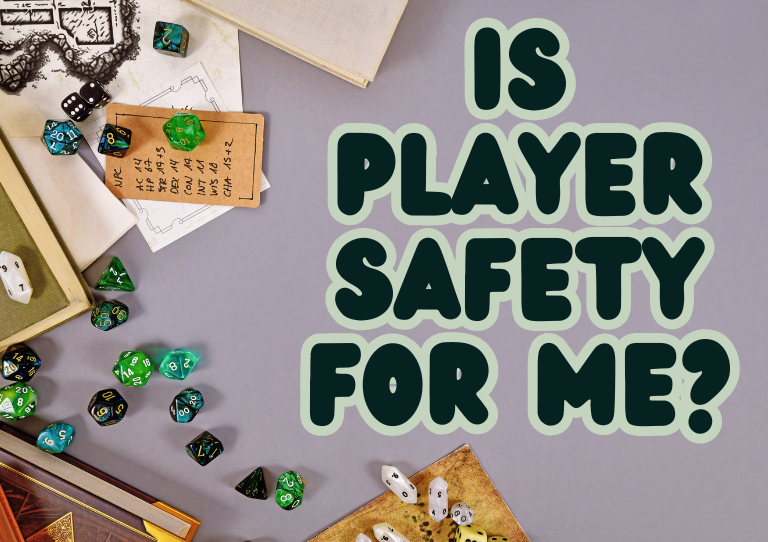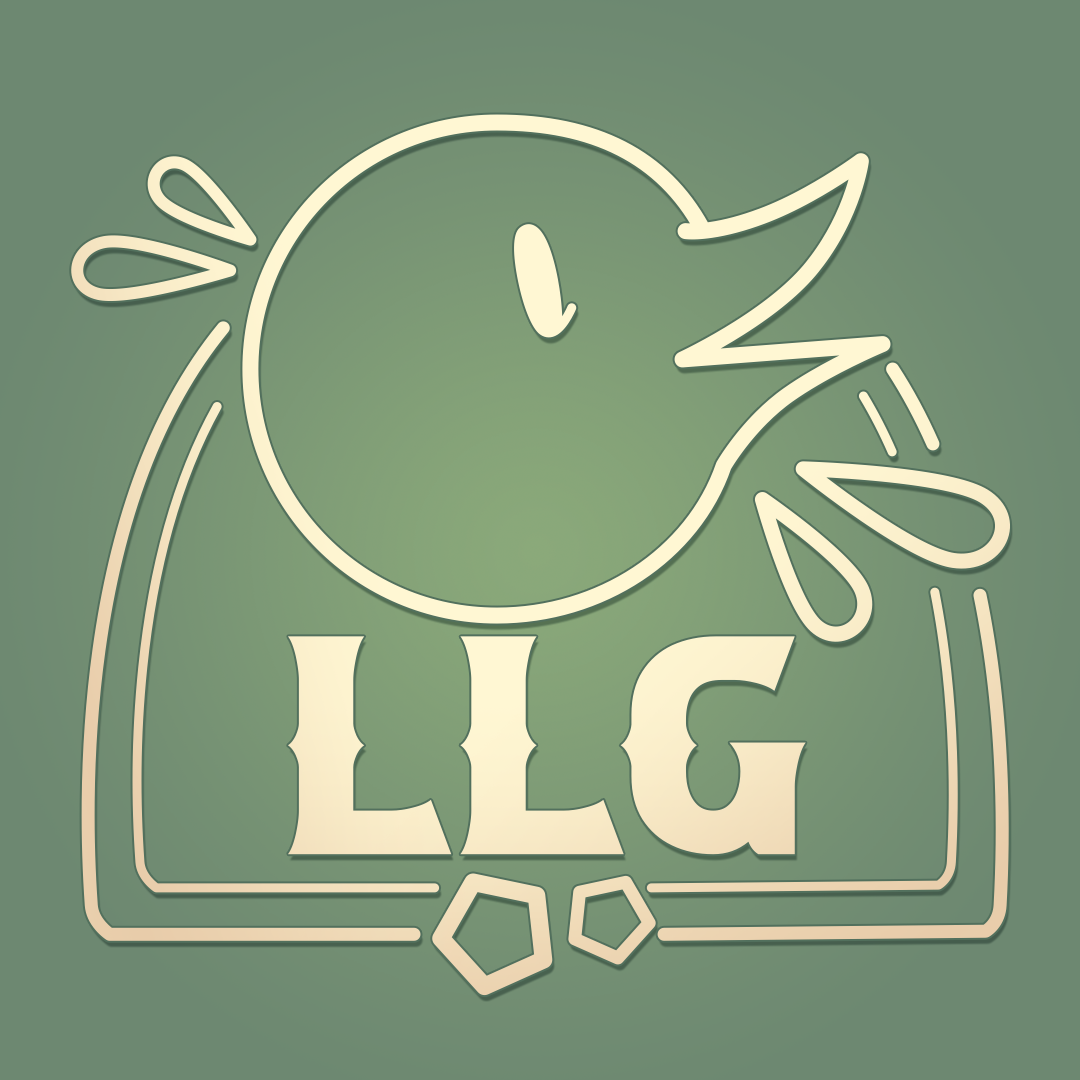Is Player Safety For Me?
April 30th, 2024
Player safety is not just an important part of running a tabletop roleplaying game, it is a necessity.

Is Player Safety For Me?
Yes. Yes, it is. Player safety is not just an important part of running a tabletop roleplaying game, it is a necessity.
Every person in the community has that hill they will die on (I would say most have many hills and a couple of mountains, actually) and mine is player safety. While this does stem from a concern and empathy for those at my table, the fact is that player safety is a requirement to run a roleplaying game with actual roleplaying. Say it with me, class: roleplaying only works when a table is safe!
You may already be practicing player safety without even knowing its definition. Player safety is creating an TTRPG environment in which the emotional needs of the players are understood and provided for with tools and practices. Safety checklists, x-cards, and stars and wishes are all examples of tools, while session zeros and debriefs are some practices that can be implemented.
The scope of this post is not to explore the tools to implement the safe table experience, but rather focusing on the ends these means provide and my own experience. I’ll explain what I mean, but first, a history lesson:
I cut my fangs on the 3rd edition of World of Darkness games back in the late 90’s. I will always cherish my fond memories of those days, but more so, I jealously hoard my painful lessons from those horrible but halcyon times. Player safety at that time was an unheard-of concept. Hell, there was not even physical safety at many of the tables I played at as a closeted teenage boy drowning in a toxic testosterone soup. Every slur, insult, and derision were flung around the table not without regard for their impact, but purposefully crafted to deliver the maximum amount of damage. Triggers were the things you pulled to blow away any NPC the GM put in your path, as well as the things you pulled to make the person next to you squirm. Had a problem with how something played out? Good. Did that make you uncomfortable? Wah. Every session was a chance to show how tough you were, how much abuse you could take, and how many dice you could roll to make the biggest explosion.
Doesn’t that sound like the most boring gaming session you can imagine?
But then the greatest thing in the universe happened to me: I gamed with Furries. Undergrad opened my eyes to a brand-new world and individuals with different perspectives. Being hopelessly addicted to gaming had me jump onto any table with an open seat, broadening my worldview exponentially with each new group I met. I joined edgelords, crunchers, goofballs, and romantics. I played in games that were statistics courses wrapped in a thin veneer of characterizations that amounted to little more than a character name, and a backstory shallower than an oil slick. One group I was in I later realized was trying to induct me into a polycule before I even knew that polygamy existed outside of Utah. The rainbow connection of tables I joined were each educational in their own way, but the group that will always stand out to me is that Furry group.
I did not know they were Furries when I joined, but quickly learned when they used terms like nuzzle, snoot, and fursona. One of them even showed me his fursuit plans. By this point in my life, I was exploring my own bisexuality and gender concepts, so thankfully I was able to be An Adult™ and learn something new and interesting. Little did I know, I was going to learn something that would reshape my entire outlook and beliefs with TTRPGs.
The Keeper (it was my first Call of Cthulhu game) sat me down and asked me if there was anything he should tread carefully around, or straight up avoid. I did not understand the question. So, he asked me if there was anything that might be broached that could be traumatic to me. Yet again, the question was entirely alien. Though in retrospect I applaud him for being so patient and kind, this conversation was a long and difficult one for me that seriously had me consider dropping out the game. I had to think for a long time on this concept before I got back to him and, even then, I said “nah, hit me with whatever you have, I’m tough.” Even at this point, he told me to pull him aside if anything got rough during the game and if I needed a break or to discuss anything.
The session he ran was heavy. I mean HEAVY. It was fun and I experienced some of the best roleplaying I had ever seen to date, but it was a draining game. Then, yet again, my foundations were rocked when he stopped the game early and offered to discuss the events that occurred so we could all get some closure before heading home. I swear, you could hear the epiphany go off in my brain like a M80. Here was a GM that cared about his players and wanted to make sure they were not emotionally harmed by the events of play. Uh, excuse me?
A few months later, I gathered my own group of friends to start playing a game. I did not do a safety checklist at this time, but I did let them know if anything bothered them in the game to tell me, and we could discuss it as needed. That campaign went on for three solid years and produced some of the greatest memories I have of gaming. During the campaign, I began to bring in new players in droves. I saw the gate and I kicked that big, ugly sonofabitch down, stomped on it, and said ooga booga to every gatekeeper I came across, sending them running for the hills.
Now, I did not take you down this memory lane to show you what a Great Guy® I am or anything, because I will be the first to tell you that I still have so much to learn about player safety. There are huge gaps in my knowledge and repertoire that I am shoring up with the help of all the wonderful advocates I’ve met in this community. My intention is to show that genuine roleplaying cannot occur if a player does not feel comfortable enough to bring their authentic being to the table. Roleplaying is about baring one’s soul to a group of people; to act goofy and vulnerable while telling a story. If a player is afraid that they will be belittled or that a situation that makes them uncomfortable will be present at the table, they are never going to open up enough to truly commit to the game.
Now, read this next part very carefully: it is not a player’s responsibility to feel comfortable at a table. It is a GM’s responsibility…and that of the other players. I’ll get to this last part a little later, but it is a concept that bears continuous, ex-horse beating repeating. But back to the head honcho at the table.
The GM is responsible for creating, cultivating, and maintaining a safe table around which players can explore the story and their characters at any given moment. Not just session zero, but from the cradle to grave, intro to wrap-up. GMs are the sole party responsible for player safety at a table, right? Wrong! The bulk of the responsibility does belong to the person owning the table, but it is a common misconception that a GM is entirely on the hook for a safe table. Other players are just as responsible for not introducing toxic behaviors or making others feel uncomfortable at the table. While a GM can and should arbitrate when a situation between players gets tense, an ounce of prevention is worth a pound of cure.
Just as a player should look for opportunities to include their fellow tablemates and throw them some spotlight moments, so too should they foster a safe and inclusive place. By working with their fellow players and the GM, a safe player can add to the gestalt comfort level of the table just by just having a compassionate perspective and being open to communication. The players themselves must also see to their own safety to an extent.
The GM can offer a generally safe table, but if a player does not take adjacency in their own well-being and communicate their concerns and needs, then a GM is not going to be able to adjust the table as needed. GMs can be empathetic, but they cannot be telepathic, after all. It really all boils down to communication.
The order of priority is to be an empathetic human first, but I contend it is not selfish to think about the fringe benefits of a safe table, as well. Players are more likely to come back to a safe table, so that will promote campaign longevity and health. Players that have their safety needs met will be in a better place to provide better performances, be more engaged with the stories, and cooperate with the party as a whole. People that run safe tables are often recommended to other players as well, so sit back and wait for the requests to roll in, good bean GM. Finally, my personal favorite, being a safe GM pisses off toxic players, who will rant and holler, making it so very easy to know who not to include at your table. It’s like when the rotten fruit starts to stink up the bowl; you know exactly which mushy peach and bruised banana to toss into the compost.
But these wonderful things do not come easily, and require work and dedication. Study those safety tools, reach out to your players, and use each and every day to become a better human being than you were yesterday. The rewards are beyond your wildest dreams.
Still with me? Good, I’m glad. I know this was a rather meandering diatribe on something that might seem self-explanatory, a real “duh” subject, but I feel that it bears broaching anyway. Often, when a topic becomes ubiquitous in conversations held in the community, that means it is nearing the dreaded state of stasis. If player safety becomes a static concept, that means things will begin to slip through the cracks, innovations will be missed, and the whole situation could regress.
I’ve seen what came before player safety and I do not want to relapse into that garbage. If you are in the TTRPG community and managed to have the mental fortitude to make it this long through my post, I urge you to keep the conversation going, challenge yourself every session, and come up with the next biggest, Greatest Thing© in player safety. I guarantee I will be the first person in line looking to learn from you.



